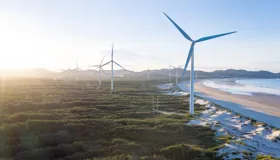CEFC sees natural capital as key to decarbonisation

This article originally appeared in [i3] Insights and is republished with permission.
9 April 2025
Building platforms with institutional partners
By Florence Chong
CEFC is partnering with institutional investors to attract patient capital to change farming practices and provide green loans for the decarbonisation of agricultural assets.
The Federal Government’s green bank, Clean Energy Finance Corporation (CEFC), sees its capital as playing a critical role in adapting farming practices and developing natural solutions to counter the corrosive impact of climate change.
Heechung Sung, Head of Natural Capital Investments at the CEFC and a long-time Macquarie Group alumnus, is driving changes through green loans for the thousands of small landholders in the Australian agricultural sector and equity investment to help attract patient capital into large scale agriculture projects.
To target the small end of town, the CEFC has committed up to $300 million in two green finance initiatives with major banks to incentivise farmers to decarbonise their assets. Sung says this segment of the market is critical for Australia.
However, carbon emissions can be hard to abate.
Recently in the natural capital space, the CEFC began co-investing with large institutional partners to establish platforms to access direct and indirect ownership of assets. The strategy is to plough capital from domestic and overseas sources to invest in the diversification of land-based solutions to deal with climate change.
We wouldn’t rule out either expanding the existing platform or establishing new ones (with CDPQ). We might seed an idea and have them invest alongside us with an investment managerHeechung SungHead of Natural Capital Investments, CEFC
In 2023, the green bank partnered with Canadian pension fund Caisse de dépôt et placement du Québec (CDPQ) to create a $200 million sustainable agricultural platform. CDPQ has invested $150 million in Wilga Farming, supported by $50 million from the CEFC.
The platform, Wilga Farming, is managed by Gunn Agri Partners. The partners now have a minority stake in Gunn Agri to help shape future sustainable agriculture and natural capital strategies to effect the decarbonisation of the manager’s existing portfolio.
The capital is almost fully deployed, Sung says, adding that they are looking at new ways to work with CDPQ to invest further into Australia.
“We are working with them to explore new strategies to showcase low carbon farming and land-based sequestration activities,” Sung says.
“That is very important, and equally such partnerships help to bring in more liquidity into the market. We are proud of the quality of our capital partners.
“We wouldn’t rule out either expanding the existing platform or establishing new ones (with CDPQ). We might seed an idea and have them invest alongside us with an investment manager. Or we might decide to keep on investing in the existing platform because there is an ambition that might be more exciting that originally conceived.”
Transforming Farming Platform targets underperforming farms
The CEFC has a $50 million cornerstone investment in the Transforming Farming Platform, established by leading Dutch asset manager, Kempen. Like the CDPQ investment, Gunn Agri is managing the assets, which include more than 12,500 hectares of mixed farmland.
The approach is to invest in underperforming small to medium farms to lift productivity and optimise land use by integrating row crops, grazing, carbon sequestration, biodiversity conservation and other natural capital assets at an institutional investment scale.
“We buy degraded assets to turn them into productive land,” Sung says. One asset, known as the Liverpool Plains, in Northern NSW, was part of the Shenhua Watermark coal exploration site. Kempen and the CEFC bought it from the Chinese company after it withdrew its mining licence.
The withdrawal enabled the land to be returned to agricultural use and created significant natural capital assets, including the formation of koala habitat conversion sites, now managed by the NSW government. The purchase resulted in farms returning to 10 local farming families.
More recently, it invested $75 million with New Forests, a global forestry and agricultural asset manager, alongside, German pension fund Bayerische Versorgungskammer (BVK), and one of Europe’s largest pension funds, Andra APfonden (AP2) in the first round of capital raising ($600m) for New Forests’ Australian New Zealand Landscapes and Forest Fund.
The CEFC sees this investment as a “landmark” deal. It is targeting carbon abatement of one million tonnes over the next decade through new planting of trees and converting hardwood plantations into softwood plantations to allow for longer rotation periods to deliver higher carbon abatement potential.
The scale of these strategies requires institutional capital to deliver projects, Sung told [i3] Insights.
“A really good example of that is our transforming farming mandate with Kempen. We can see further strategic opportunities which potentially require more capital to expand and reshape the mandate to focus much more on a land-based sequestration strategy of environmental planting.
“Our investment is needed where the strategy requires long-term capital. We have investment in ag tech venture capital. You need the right capital and the investment strategy.
“The thing I would highlight is capital partners are generally pension funds with long-term investment horizons, which are important as you need patience to ride through the cycle volatility. With the right operating model and the right investment horizon, over the past decade, investments delivered strong results.
“Our first investment – accounting for 10 per cent of the capital raised – was in the 12-year Macquarie Agriculture Fund. We helped seed the first close, which then achieved a final close of $1 billion from foreign pension funds.”
This fund is halfway through its investment term, and Sung says: “We are learning from that strategy, and we are starting to see the data come through. The investment was made in 2018, and the fund is performing well with strong returns and is meeting our decarbonisation targets. We are seeing some interesting adoption of sequestration strategies.”
“We are looking at both sides of the carbon problem in the land-based sector. One is big sectors, such as forestry and agriculture, which rely on natural capital solutions to decarbonise greenhouse gas emissions.
“Then, there are some 85,000 individual farmers and to reach them we have worked with the CSIRO to develop tools, such as the Towards Net Zero Agriculture Pathfinder, to help them decarbonise, alongside meaningful discounted financing products. The other side of the carbon ledger is the land-based sinks which provide natural solutions for emission abatements.”
Discount loans for environmental planting
Early this year, the CEFC launched a concessional financing facility with the National Australia Bank (NAB) to farmers as term loans for operations and capital expenditure to decarbonise their assets.
“We are putting capital to help various sectors that are hard to decarbonise. Part of our mission and remit is not only to invest in energy transition but to also invest in hard to abate sectors to achieve lower emissions as we aim to get to net zero in 2050. Net zero in 2050 is a scientific target, and we are addressing it with science in mind.”
The initiative is an innovative approach to help farmers with their upfront cost to decarbonise, and we are also offering solutions to help them achieve their goals.
With that in mind, the CEFC and CSIRO have developed the Pathfinder tool to help farmers establish a baseline on the emissions of their assets and consider the key various science-led strategies to support decarbonising their assets and to accelerate their net zero journey, she says.
“It is important we provide a financial structure, with a science backed tool that offers practical assistance.”
We are working with Rabo to lend to farmers who want to grow local species to generate additional income streams for farmers, which can also serve to provide shelter belts for livestock producers. There are a number of ways that you can configure a farm for environmental planting, but there is an upfront costHeechung SungHead of Natural Capital Investments, CEFC
The CEFC has also teamed up with specialist global agricultural bank Rabobank. It has committed a A$200 million allocation towards loans to implement environmental planting projects on properties to produce carbon credits for sale to government regulated carbon credit markets.
“We are working with Rabo to lend to farmers who want to grow local species to generate additional income streams for farmers, which can also serve to provide shelter belts for livestock producers. There are a number of ways that you can configure a farm for environmental planting, but there is an upfront cost.”
The CEFC finance is used to reduce interest on the loan by 1 per cent with Rabo contributing a further discount of 0.15 per cent, making a total discount of 1.15 per cent.
The arrangement similar to the one established with NAB. “We have set aside $100m of the NAB facility to provide 1.15 per cent discount. In addition, we have a $200m facility with the bank for low carbon machinery and equipment available to small medium size companies, including farmers.”
According to Climate Works, Australia has to remove 4.6 gigatonnes of carbon through land-based sequestration to meet net zero in 2050 under a 1.5-degree scenario, so that is, as Sung sums up, “a lot trees that you have to plant in the ground”.
That is the enormity the carbon problem.
[i3] Insights is the official educational bulletin of the Investment Innovation Institute [i3]. It covers major trends and innovations in institutional investing, providing independent and thought-provoking content about pension funds, insurance companies and sovereign wealth funds across the globe.




